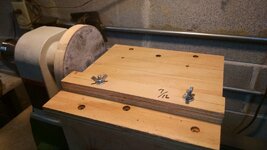Swagopenturner
Member
I ordered one of Woodpecker's new Pen Mill last December and received it around the 5th of January. I bought the 13 piece set with all the pilot shafts available. Yeah, it was expensive compared to other pen mills available.
Since then I have been putting it through its paces making 75 or so pen kits, both single and double barrel blanks.
Overall impression: Extremely well built and engineered. Very aggressive! It cuts anything I have put to it with ease; Stone, metal, acrylics, and very hard wood blanks.
Warnings: Go VERY slowly and lightly when using this tool! I highly recommend using one of those locking plies with the rubber coated jaws to hold your work. I used to just grab the blank to be trimmed in my hand and hold it up to the spinning pen mill. This tool can be very scary! I equate it to putting your hand very close to a spinning router bit and hoping note to let your skin come in contact!
Don't drop the tool on a hard workbench or floor. The carbide cutters can easily break.
Would I buy it again? Most definately. Even with the added expense, the kit is a very good tool for the serious pen maker. Compared to the other pen mills (I compared the Woodpecker's to PSI and Whiteside), I believe it is a better value, works faster, and cleaner.
Since then I have been putting it through its paces making 75 or so pen kits, both single and double barrel blanks.
Overall impression: Extremely well built and engineered. Very aggressive! It cuts anything I have put to it with ease; Stone, metal, acrylics, and very hard wood blanks.
Warnings: Go VERY slowly and lightly when using this tool! I highly recommend using one of those locking plies with the rubber coated jaws to hold your work. I used to just grab the blank to be trimmed in my hand and hold it up to the spinning pen mill. This tool can be very scary! I equate it to putting your hand very close to a spinning router bit and hoping note to let your skin come in contact!
Don't drop the tool on a hard workbench or floor. The carbide cutters can easily break.
Would I buy it again? Most definately. Even with the added expense, the kit is a very good tool for the serious pen maker. Compared to the other pen mills (I compared the Woodpecker's to PSI and Whiteside), I believe it is a better value, works faster, and cleaner.














